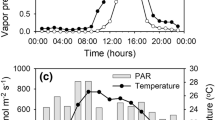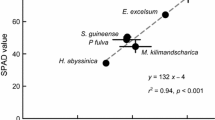Abstract
We evaluated the hypothesis that photosynthetic traits differ between leaves produced at the beginning (May) and the end (November–December) of the rainy season in the canopy of a seasonally dry forest in Panama. Leaves produced at the end of the wet season were predicted to have higher photosynthetic capacities and higher water-use efficiencies than leaves produced during the early rainy season. Such seasonal phenotypic differentiation may be adaptive, since leaves produced immediately preceding the dry season are likely to experience greater light availability during their lifetime due to reduced cloud cover during the dry season. We used a construction crane for access to the upper canopy and sampled 1- to 2-month-old leaves marked in monthly censuses for six common tree species with various ecological habits and leaf phenologies. Photosynthetic capacity was quantified as light- and CO2-saturated oxygen evolution rates with a leaf-disk oxygen electrode in the laboratory (O2max) and as light-saturated CO2 assimilation rates of intact leaves under ambient CO2 (Amax). In four species, pre-dry season leaves had significantly higher leaf mass per unit area. In these four species, O2max and Amax per unit area and maximum stomatal conductances were significantly greater in pre-dry season leaves than in early wet season leaves. In two species, Amax for a given stomatal conductance was greater in pre-dry season leaves than in early wet season leaves, suggesting a higher photosynthetic water-use efficiency in the former. Photosynthetic capacity per unit mass was not significantly different between seasons of leaf production in any species. In both early wet season and pre-dry season leaves, mean photosynthetic capacity per unit mass was positively correlated with nitrogen content per unit mass both within and among species. Seasonal phenotypic differentiation observed in canopy tree species is achieved through changes in leaf mass per unit area and increased maximum stomatal conductance rather than by changes in nitrogen allocation patterns.
Similar content being viewed by others
Author information
Authors and Affiliations
Additional information
Received: 7 March 1996 / Accepted: 1 August 1996
Rights and permissions
About this article
Cite this article
Kitajima, K., Mulkey, S. & Wright, S. Seasonal leaf phenotypes in the canopy of a tropical dry forest: photosynthetic characteristics and associated traits. Oecologia 109, 490–498 (1997). https://doi.org/10.1007/s004420050109
Issue Date:
DOI: https://doi.org/10.1007/s004420050109




